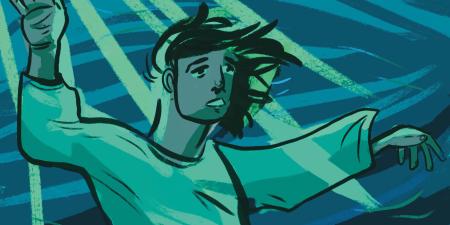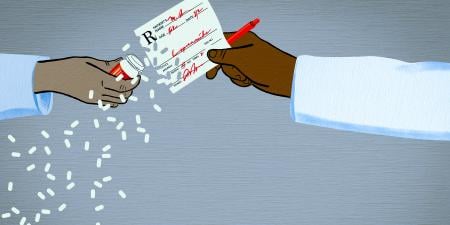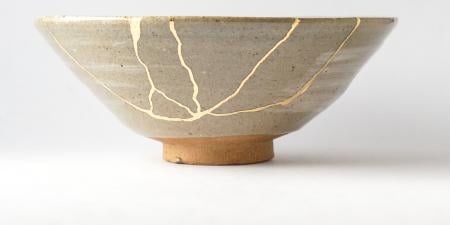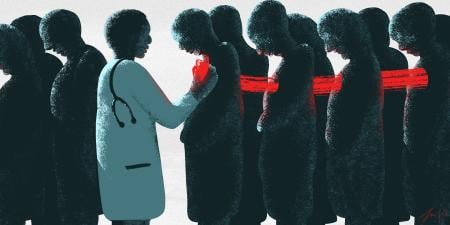Abstract
The “model minority” myth (MMM) has far-reaching implications for Asian Americans in many settings, including medicine. For clinicians working with first-generation Asian American college students, this article considers 3 factors that affect how the MMM plays out in clinical care: clinicians’ racial identity awareness, cross-racial dynamics, and the extent to which a patient has internalized racism or oppression.
Case
JJ is a student doing a rotation in a university clinic. JJ’s patient introduces himself as “Todd” and is an 18-year-old Chinese American student who states that he hasn’t been feeling well. As JJ talks with Todd, JJ learns that Todd studies electrical engineering and that his parents, brother, and sister run a restaurant in a neighboring state. JJ notices Todd’s flat affect and difficulty maintaining eye contact1 and asks Todd about his courses, part of a curriculum widely known for its rigor and intensity. As JJ leafs through Todd’s health record, a clinic note from 3 months ago suggests Todd experienced suicidal ideation.2,3
JJ continues to try to engage Todd, who says, “Classes are fine. My engineering project group goes out for drinks without me, though, typically leaving me with group problem sets to do alone. I hate that.”
JJ responds, “I see why you hate it: that’s a lot of pressure.”
Todd denies that this is the case. “Sorry,” he says, “I shouldn’t have brought it up. It doesn’t matter. I just have to get this degree so I can help my family and make my parents happy we came to this country.”
JJ wonders what to say next.
Commentary
Research on Asian American students overwhelmingly focuses on the existence and impact of the “model minority” myth (MMM), especially on academic performance. The myth suggests that Asian Americans work hard and are successful despite racial discrimination. It was originally introduced to undercut the civil rights movement by suggesting that racism can be overcome by hard work and achieving the American Dream.4,5,6 Indeed, the MMM was one means of pitting Asian Americans against other racial groups—specifically, wedging them between White and Black Americans.7 However, the MMM can itself lead to discrimination against Asian Americans across many settings, including medicine. Non-Asian Americans who endorse the MMM are more likely to perceive Asian Americans as psychologically healthy,8 generally healthier overall, and the least likely racial group to suffer from any disease.9 Thus, the MMM has contributed to the larger public belief that Asian Americans are healthier than other minoritized ethnic groups.9 Belief in the MMM might contribute to clinician bias that in turn contributes to underscreening for cancer,9 overlooking of mental health symptoms,10 and mistrust of clinicians in Asian American patients.10
Researchers and scholars in education, psychology, and Asian American studies consistently agree that there is a lack of scientific evidence for the model minority image of Asian American students as intelligent overachievers.11,12 A closer look at the data shows that Asian American students vary widely in their academic abilities and that racism and oppression have a deep impact on the psychological health and academic outcomes of these students,11,12,13 especially Southeast Asian14 and Pacific Islander students.15 Despite being a gross oversimplification and overgeneralization, the MMM remains a firmly held belief within many Asian American communities16 and among the broader US public. Asian Americans continue to report experiencing racism on a daily basis on multiple levels, including individually, interpersonally, institutionally, and societally.17 Racial discrimination, in turn, has been consistently shown to be related to poor health and poorer mental health.18 Consequently, it is important for clinicians to understand that stereotypes like the MMM are likely to affect the way they perceive their Asian American patients, the way they judge symptoms that are presented or absent, and the medical choices they offer and diagnoses they ascribe to Asian American patients.
Below we present 3 considerations for clinicians and educator-clinicians to note while serving first-generation, Asian American college students presenting with depressive symptoms in the clinic and facing the model minority stereotype while navigating college life. Awareness of these factors, including the clinician’s racial positionality, the role of cross-racial dynamics, and the extent of the patient’s internalized oppression, are important to consider alongside the MMM and its negative outcomes (eg, exacerbated psychological distress and further health care disparities). In offering these considerations, we posit that understanding racial dynamics allows clinicians to more effectively navigate their interactions with the patient and amplifies clinicians’ ability to advocate for the patient and address the patient’s needs.
Racial Identity Awareness
The extent to which you, as a clinician, internalize a positive racial identity affects the way you interact with other people within and outside of your racial group. This process is referred to as racial and ethnic identity development.19,20 In other words, how do you think about the concept of race and your personal race affiliation? Not thinking about one’s race is also an identified stage in racial identity development and ought to be explored. By starting with the self, clinicians lower the chances of projecting their own unexamined issues onto the client. For example, college students sometimes experience emotional discomfort if attending a college with more racial diversity than their hometown.11 Racially unaware clinicians might not understand how normal and difficult this experience might be if they themselves have not experienced it. In this way, clinicians might perpetuate implicit beliefs that are inherent to the MMM, such as the belief that Asian Americans will be academically successful if they just work at it. The clinician might downplay or normalize the stress and pressure that the patient feels and miss possible depressive symptoms such as fatigue, excessive guilt, low mood, and anhedonia. These symptoms might be ascribed to the student patient’s academic workload rather than being appropriately assessed as an indication of depression. Two experimental studies found that, when exposed to the MMM, participants were significantly more likely to perceive Asian Americans as having better mental health functioning and fewer clinical symptoms10 and were less likely to diagnose alcohol use disorders21 than when not primed with the MMM.
Asian Americans who uphold the MMM might work against their own best interest in order to maintain the racial hierarchy and their position above other racial minorities.
Clinicians who do not acknowledge the importance of race and racial experiences might also believe that Asian Americans only experience mild racism or are not affected by the racism they do experience. Indeed, studies show that doctors and other practitioners hold cultural stereotypes about Asian Americans.22 Consequently, these clinicians might decide that racial stereotypes of success are not stressful, oppressive, or harmful, as research on the underscreening of cancer in Asian Americans9 might suggest that members of this group already have all the necessary medical resources and services. If this is the case, Asian Americans presenting with mental health concerns must not need resources or accommodations, either. As a result, clinicians might work with Asian American patients on internal regulation and control rather than on externalizing or minimizing self-blame, which has been shown to be most effective in coping with race-related stressors.23 One strategy for regulating racial bias that clinicians could apply to themselves is simply being aware of and acknowledging their racial identity and possible racial biases.24 Indeed, when clinicians, especially White clinicians, are aware of their racial biases or made aware of these biases, they are more likely to make adjustments and work harder to adjust their prejudicial behaviors.25
Cross-Racial Dynamics
Perception of others. After you understand your own racial identity, you can attend to the patient’s understanding of race and the impact of the MMM on the patient. Cross-racial dynamics26 refers to the relational pushes and pulls, norms, and standards that exist among individuals belonging to or identifying with different racial groups. In other words, how do you relate to members of other racial groups? What implicit biases do you hold, and how do they show up when you interact with other people? Research has consistently found that medical practitioners are biased in their treatment of patients of color generally27 and Asian American patients in particular.28,29 One study of Asian Americans found that experiences of language discrimination (ie, being treated unfairly or with disrespect due to lack of fluency in English) is more strongly associated with chronic health conditions for those who have lived in the United States for 10 or more years than for more recent arrivals.30 It is possible that biased experiences with health care professionals lead Asian American patients to avoid returning for subsequent health issues. This behavior would then contribute to health care professionals believing that Asian American patients do not need their services, which aligns with the MMM beliefs discussed earlier.
Others’ perception of self. It is also important for clinicians to understand how they are likely to be perceived by their Asian American patients. Racial dynamics comprise the perceptions of all individuals involved. Extant literature suggests that patients’ mistrust in the therapeutic relationship frequently stems from clinicians’ stereotype bias and lack of awareness of racialized power and privilege.31,32 Therefore, clinicians whose racial identity might not be readily perceived by others (eg, mixed race, racially ambiguous) have the additional task of understanding how their racial appearance affects them personally and their therapeutic relationships. For example, racially mixed or racially ambiguous-appearing people who are denied their American or White identity experience greater stress and are more likely to react by verbally asserting their identity than those who experience an identity-irrelevant denial.33 Clinicians should be aware of the potential for this scenario to arise and be mindful of the patient’s perception of the clinician’s race. An Asian American student with low English proficiency interacting with a White-presenting, Latinx clinician might not ask for a translator because they hope to be accepted as more “American.” Asian Americans like this one are likely struggling with the MMM and have tended to assimilate English-language norms (ie, good Americans learn English and are not a burden to others). Had the student perceived the clinician to be Latinx, perhaps they would have felt more comfortable asking for a translator. Understanding one’s personal racial identity and race relations will guide best practices for working with Asian American student patients.
Generational status. Asian American clinicians must consider possible biases attached to their patient’s ethnicity and generational status, as well as their own. For example, US-born Asian Americans or even US-trained Asian American clinicians might approach physical and mental health in a more westernized way relative to first-generation Asian Americans. Accordingly, clinicians working with first-generation Asian Americans would benefit from considering Asian American indigenous healing practices, such as detoxing and use of medicinal herbs.34,35 The integration of traditional healing practices with Western medicine allows for the strengthening of trust in the patient-clinician alliance and the development of culturally appropriate care.16
First-generation Asian immigrants often report different acculturation patterns than their US-born counterparts,36,37 such that they anticipate the need to behave differently in non-Asian dominant spaces. Consequently, postmigration and adjustment issues may present as depressive symptoms in first-generation immigrants. Isolation and loneliness are common feelings for college students away from home for the first time and might be amplified for newly arrived international students. Note that international students are technically not considered immigrants. First-generation immigrants typically refer to green card holders, foreign-born US citizens, Deferred Action for Childhood Arrivals recipients, and other undocumented immigrants. Nevertheless, international students are likely to present at the clinic and have unique concerns. For example, international students and other students who have recently immigrated are likely to have a harder time adjusting to cultural differences and potentially the English language, depending on their country of origin (although some Asian countries are English fluent, such as India and the Philippines).
First-generation immigrants often have less US experience and historical knowledge to contextualize their experiences of discrimination. Having historical knowledge of US racial oppression and the minoritization of Asian Americans along with other people and communities of color allows these individuals to externalize their experiences of racial discrimination.13 For example, if a first-generation immigrant student is asked to “Americanize” their name so English speakers will have an easier time saying it, they are likely to believe that they are at fault for having an unusually difficult name. A US-born student receiving a similar request to change their name to simplify their English-speaking clinician’s or peer’s life might be more able to externalize the incident, depending on their racial identity development. This individual might say, “This is a racist request that people of color often receive from people of European descent and stems from a history of colonizing both other people’s land and body.”
More recently arrived Asian Americans are also likely coming from a home country where they are part of the racial and ethnic majority group (eg, Thai person living in Thailand). This period of residence in the United States might be the first time in their life when they are part of the minority group. Immigrants who do not identify as bicultural—who are not able to fully engage in both their culture of origin and the new US culture—often report more depressive symptoms than bicultural immigrants.38
Ultimately, clinicians need to adjust their approach to their patient’s needs. For patients who are low in understanding societal-level oppression, be careful about pushing for work on internal processes alone and inadvertently suggesting that the individual is deficient. Instead, a more just approach would be to balance helping patients learn about the US racial historical context and the existence and history of the MMM with building their sense of agency to combat the effects of the MMM. For patients who are only focused on societal-level oppressive forces, understanding where their internal controls lie might be helpful.
Patients’ Internalization of the MMM
If we begin from the position of believing the science that suggests that the MMM is indeed a myth, then we can understand that Asian Americans’ endorsements of and belief in the MMM constitute internalized racism or oppression (ie, internalization of the MMM). Understanding the extent to which the patient has internalized the MMM is another means of considering the patient’s positionality within the racial dynamics of the therapeutic relationship.39 The MMM plays out for Asian Americans in myriad ways.40,41 On the one hand, Asian Americans sometimes play into the myth, believing that it helps them appear “good” and even smarter than other students. This stance, however, might contribute to a lack of confidence, chronic anxiety, and the development of imposter syndrome if they feel the MMM helps them appear smarter or better than they actually feel they are. Research suggests that Asian Americans who internalize the MMM show higher levels of psychological distress and more negative views of help-seeking behaviors.42 On the other hand, the MMM relies on there being a racial hierarchy, with White Americans at the top as the dominant majority and Asian Americans at the top among racial minorities. Consequently, Asian Americans who uphold the MMM might work against their own best interest in order to maintain the racial hierarchy and their position above other racial minorities, such as by advocating for racially color-blind policies.
There are several ways for clinicians to support patients who have internalized the MMM. One way to minimize stereotyping and allow for a supportive and culturally informed program for navigating the MMM might be to build patient-support groups that are run by fellow Asian American patients. Clinicians might also consider developing support groups at university clinics to allow Asian American patients to work with one another. Meditation groups have been found to provide relief for Asian Americans dealing with racism-related stressors and presenting with depressive symptoms.43 While this approach eliminates cross-racial dynamics, other in-group dynamics (eg, gender, immigration status, ethnic group affiliation) may be present; thus, practitioners must be cautious of presuming that this support group would be helpful to all Asian Americans.44
Conclusion
Best practices for working with first-generation Asian American college students entail cultural knowledge, empathic understanding, and a balanced approach to internal regulation and externalization of problems. To develop these resources and skills, clinicians need to be knowledgeable about their racial positionality, cross-racial dynamics, and the internalization of the MMM.
References
- Wartberg L, Kriston L, Thomasius R. Depressive symptoms in adolescents: prevalence and associated psychosocial features in a representative sample. Dtsch Arztebl Int. 2018;115(33-34):549-555.
- Primananda M, Keliat BA. Risk and protective factors of suicidal ideation in adolescents. Compr Child Adolesc Nurs. 2019;42(suppl 1):179-188.
- Zhang J, Fang L, Wu YW, Wieczorek WF. Depression, anxiety, and suicidal ideation among Chinese Americans: a study of immigration-related factors. J Nerv Ment Dis. 2013;201(1):17-22.
-
Chan S. Asian Americans: An Interpretive History. Twayne; 1991.
-
Wu E. The Color of Success: Asian Americans and the Origin of the Model Minority. Princeton University Press; 2014.
-
Lang C. The Asian American response to Black Lives Matter is part of a long, complicated history. Time. June 26, 2020. Accessed January 19, 2021. https://time.com/5851792/asian-americans-black-solidarity-history/
- Bonilla-Silva E. From bi-racial to tri-racial: towards a new system of racial stratification in the USA. Ethn Racial Stud. 2004;27(6):931-950.
-
Yam K. The mental health toll of being a “model minority” in 2020. NBC News. December 23, 2020. Accessed January 21, 2020. https://www.nbcnews.com/news/asian-america/mental-health-toll-being-model-minority-2020-n1249949
- Ibaraki AY, Hall GCN, Sabin JA. Asian American cancer disparities: the potential effects of model minority health stereotypes. Asian Am J Psychol. 2014;5(1):75-81.
- Cheng AW, Chang J, O’Brien J, Budgazad MS, Tsai J. Model minority stereotype: influence on perceived mental health needs of Asian Americans. J Immigr Minor Health. 2017;19(3):572-581.
-
Suzuki BH. Revisiting the model minority stereotype: implications for student affairs practice and higher education. New Dir Stud Leadersh. 2002;97:21-32.
- Tran N, Birman D. Questioning the model minority: studies of Asian American academic performance. Asian Am J Psychol. 2010;1(2):106-118.
- Atkin AL, Yoo HC, Yeh CJ. What types of racial messages protect Asian American adolescents from discrimination? A latent interaction model. J Couns Psychol. 2019;66(2):247-254.
-
Yang K. Southeast Asian American children: not the “model minority.” Future Child. 2004;14(2):127-133.
- Kwan PP, Soniega-Sherwood J, Esmundo S, et al. Access and utilization of mental health services among Pacific Islanders. Asian Am J Psychol. 2019;11(2):69-78.
- Lee S, Juon HS, Martinez G, et al. Model minority at risk: expressed needs of mental health by Asian American young adults. J Community Health. 2009;34(2):144-152.
-
Young K, Takeuchi D. Racism. In: Lee LC, Zane N, eds. Handbook of Asian American Psychology. Sage; 1998:401-432.
- Gee GC, Ro A, Shariff-Marco S, Chae D. Racial discrimination and health among Asian Americans: evidence, assessment, and directions for future research. Epidemiol Rev. 2009;31(1):130-151.
-
Helms JE. Black and White Racial Identity: Theory, Research, and Practice. Greenwood Press; 1990.
-
Phinney JS, Kohatsu EL. Ethnic and racial identity development and mental health. In: Schulenberg J, Maggs JL, Hurrelmann K, eds. Health Risks and Developmental Transitions During Adolescence. Cambridge University Press; 1997:420-443.
- Cheng AW, Iwamoto DK, McMullen D. Model minority stereotype and the diagnosis of alcohol use disorders: implications for practitioners working with Asian Americans. J Ethn Subst Abuse. 2018;17(3):255-272.
-
Bloombaum M, Yamamoto J, James Q. Cultural stereotyping among psychotherapists. J Consult Clin Psychol. 1968;32(1):99.
- Miller MJ, Keum BT, Thai CJ, et al. Practice recommendations for addressing racism: a content analysis of the counseling psychology literature. J Couns Psychol. 2018;65(6):669-680.
- Burgess D, van Ryn M, Dovidio J, Saha S. Reducing racial bias among health care providers: lessons from social-cognitive psychology. J Gen Intern Med. 2007;22(6):882-887.
-
Monteith M, Arthur S, Flynn S. Self-regulation and bias. In: Dovidio JF, Hewstone M, Glick P, Esses VM, eds. SAGE Handbook of Prejudice, Stereotyping, and Discrimination. Sage; 2010:493-507.
-
McRae MB, Short EL. Racial and Cultural Dynamics in Group and Organizational Life: Crossing Boundaries. Sage; 2009.
- van Ryn M, Burgess DJ, Dovidio JF, et al. The impact of racism on clinician cognition, behavior, and clinical decision making. Du Bois Rev. 2011;8(1):199-218.
- Leong FT. Counseling and psychotherapy with Asian-Americans: review of the literature. J Couns Psychol. 1986;33(2):196-206.
-
Ho IK, Lawrence JS. The role of social cognition in medical decision making with Asian American patients. J Racial Ethn Health Disparities. Published online September 14, 2020.
- Yoo HC, Gee GC, Takeuchi D. Discrimination and health among Asian American immigrants: disentangling racial from language discrimination. Soc Sci Med. 2009;68(4):726-732.
- Chang DF, Berk A. Making cross-racial therapy work: a phenomenological study of clients’ experiences of cross-racial therapy. J Couns Psychol. 2009;56(4):521-536.
- Kim PY, Kendall DL, Cheon HS. Racial microaggressions, cultural mistrust, and mental health outcomes among Asian American college students. Am J Orthopsychiatry. 2017;87(6):663-670.
- Albuja AF, Gaither SE, Sanchez DT, Straka B, Cipollina R. Psychophysiological stress responses to bicultural and biracial identity denial. J Soc Issues. 2019;75(4):1165-1191.
-
Yeh CJ, Kwong A. American Indigenous healing and coping. In: Tewari N, Alvarez AN, eds. Asian American Psychology: Current Perspectives. Lawrence Erlbaum/Taylor & Francis; 2009:559-574.
- Choi NG, Kim J. Utilization of complementary and alternative medicines for mental health problems among Asian Americans. Community Ment Health J. 2010;46(6):570-578.
- Miller MJ, Yang M, Hui K, Choi NY, Lim RH. Acculturation, enculturation, and Asian American college students’ mental health and attitudes toward seeking professional psychological help. J Couns Psychol. 2011;58(3):346-357.
- Murray KE, Klonoff EA, Garcini LM, Ullman JB, Wall TL, Myers MG. Assessing acculturation over time: a four-year prospective study of Asian American young adults. Asian Am J Psychol. 2014;5(3):252-261.
- Bulut E, Gayman MD. Acculturation and self-rated mental health among Latino and Asian immigrants in the United States: a latent class analysis. J Immigr Minor Health. 2016;18(4):836-849.
- Poupart L. The familiar face of genocide: internalized oppression among American Indians. Hypatia. 2003;18(2):86-100.
-
Kim GS. Asian Americans as model minority. In: Scarlett WG, ed. The SAGE Encyclopedia of Classroom Management. Sage; 2015:45-46.
- Kim PY, Lee D. Internalized model minority myth, Asian values, and help-seeking attitudes among Asian American students. Cultur Divers Ethnic Minor Psychol. 2014;20(1):98-106.
- Gupta A, Szymanski DM, Leong FT. The “model minority myth”: internalized racialism of positive stereotypes as correlates of psychological distress, and attitudes toward help-seeking. Asian Am J Psychol. 1990;2(2):101-114.
- Hwang WC, Chan CP. Compassionate meditation to heal from race-related stress: a pilot study with Asian Americans. Am J Orthopsychiatry. 2019;89(4):482-492.
- French SE, Tran N, Chávez NR. Exploring the effect of in-group and out-group race-related stressors on anxiety among Asian Pacific Islander American students. J Appl Soc Psychol. 2013;43(suppl 2):E339-E350.



